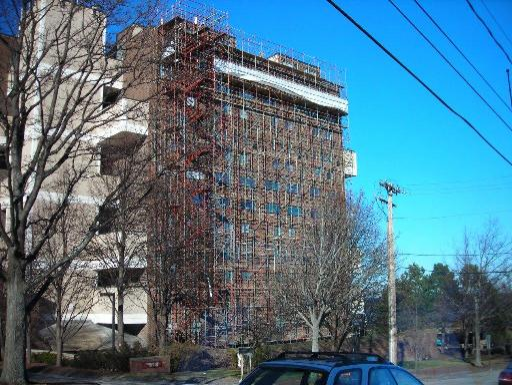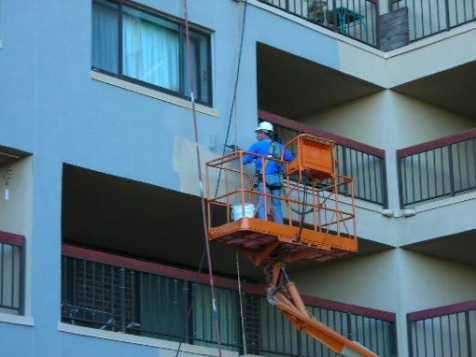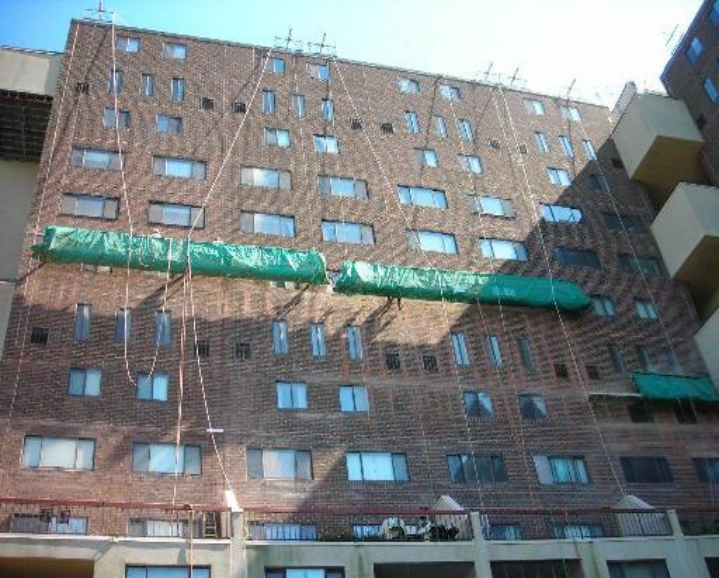Project Details
Façade Repair and Waterproofing - Portland, Maine
In 1975, the Promenade East Condominiums were constructed in a 14-story building on the corner of Walnut Street and the Eastern Promenade. Since then it has been one of the two noticeable high rise structures on the Eastern Promenade landscape. The building is a precast brick panel style of construction. The 160 panels are each 9’ high by 25’ wide and were anchored to the steel framework with steel pins. Each panel was then mortared together on the horizontal joints and a flexible sealant was used on the vertical joints. Two problems arose as a result of this particular type of construction. First, the utility brick that was used in the construction was extremely porous, which is not compatible with New England’s freeze and thaw cycles. As water penetrated deeper and deeper into the brick, it began to cause water damage on the inside of the building. In addition, the freeze and thaw cycles saturated the brick and caused failed mortar joints, steel corrosion, and brick and panel movement which in turn cracked the bricks.
Unique Projects
A second, and more problematic issue, was the waterproofing additive that was used in the mortar. This additive has since been linked to many failures in applications where steel comes into contact with mortar containing the additive. At the time of construction it was not known that this additive aided in the increased deterioration rate of steel. However, over the years the panel connectors and embedded wire lattice (Dur-o-wall) had deteriorated to a point where the panels were moving enough to crack some of the brick. Also, the deterioration of the lattice caused many of the mortar joints to crack and rust-bleed. This was obviously a concern for the owners as an imminent failure was presenting itself. Two of the panels had moved as much as 4” out of plane from the adjacent panels or corner wall.
Of the 50 buildings that were built using this type of construction in the United States, this is the only one that exists in a cold climate. All of the other 49 are in the southern United States, and 48 of the 50 were repaired or re-clad long ago due to the same mortar issues. The only original building that remains today is in Arizona.
The Promenade East Condominium Association awarded the building restoration and waterproofing to Knowles Industrial Services of Gorham. Wiss, Janney, Elstner Associates (WJE) of Boston, MA provided plans, specifications and construction monitoring for this technically challenging project. As part of this restoration and waterproofing project, all of the windows in the entire building were replaced with new energy efficient units. In addition, a large quantity of rotten stucco and substrate plywood on the exterior of the stairwells was repaired or replaced. These two items of work were performed by other contractors hired directly by the owner. Future items to be completed are the replacement of all the exterior wall drywall that has been damaged over the years and upgrades to the elevator fire safety systems.
Complications and concerns included staging and scaffolding erection on a high rise with almost constant high winds and also access for the owner and all of the occupants of the building. Winter construction required supplemental heat to protect the masonry against freezing temperatures and to prevent heat loss from the units through openings in the walls.
During the project, many unanticipated conditions arose as crews started removing deteriorated bricks. Some of these included interior slab elevation differences, missing steel pins and plates, and no wall insulation or vapor barrier. The biggest unanticipated issue that was the discovery of a negative air draw into the building. After researching and testing, the engineers calculated that the HVAC system was drawing at least 5 times the necessary pressure needed for the building’s operation, causing enormous negative pressure and air flow in the outer air cavity of the building. Knowles worked closely with the owner and WJE to provide practical restoration solutions that saved money on the project.
Contribution to the Community
What has been described in the past by some as an eyesore on the skyline of the Eastern Prom has become more of a landmark after being softened by the architect’s choice in colors, highlighting of the windows, and installation of horizontal flashing to highlight the levels of the building. The goal was to try to have the building blend into the skyline rather than stand out. Both owners and neighbors are now proud of their building. Since the project’s completion, the selling market for these units has also attracted more interest. This building’s restoration, combined with the new school built nearby, gives the Eastern Prom a look of revitalization and hope for more improvements to come.
Innovation in Construction Techniques and Materials
It was clear from the beginning that this was going to be a one of a kind project. It would require the innovative use of carbon fiber rods, an epoxy paste for panel strengthening, a shelf angle design, anchoring and sealing of the panels, and the use of aluminum cover flashing detail to architecturally cover the structural work and waterproof the connections.
The other 48 buildings of this design were repaired by re-cladding the exterior with a composite siding material attached to the outside of the brick panels. This gave the buildings a completely different look at a much greater expense. The owners of this building considered that option for this project, but the cost was nearly three times greater than the cost of the work that we completed.
The use of carbon fiber rods had just recently begun being used for masonry structure strengthening and stabilization. It is unique to use these rods in these types of panels, and using them in both vertical and horizontal panels with different depths was a first. The carbon fiber rods, which are the size of a pencil in diameter, were inserted in a bed of epoxy paste. They were then covered with more epoxy paste to completely embed the carbon fiber rods. The continuous rods stabilize the brick panels from flexing under heavy winds loads.
The use of the specifically designed structural shelf angle support was also a first for supporting such panels. The panels needed to be supported both at the tops and bottoms to stabilize them from shifting or dropping due to the deterioration of the attachment pins that were used in the original construction. The shelf also had to be watertight to the interior cavity, as well as watertight to the panels it was supporting. A cover flashing detail was fabricated out of aluminum and design to “pop” into place by applying pressure to the middle. The pressure caused it to flex over the edge of the steel angle on the top and bottom of the support shelf detail and then lock in place. At this point it was double sealed with silicone to keep the weather elements out.
At the top panel of the building where a support angle could not be tied into the roofing structure, Helafix anchors were used to tie the top of the brick panels to the concrete in the roof parapet. All the anchors, including the epoxy anchors holding the support shelf angles in place, were tested and approved by an outside testing agency for minimum design loads, prior to installation of the final flashing pieces. To tie the whole repair system together and make it water tight, the panels were sealed vertically with silicone sealant. In addition, the entire exterior of the building was coated with two coats of an elastomeric silicone, which was done in different colors.
Challenges of This Difficult Job
The weather was a constant obstacle with regards to temperatures and wind. We attached reinforced poly and additional anchoring points as recommended by the manufacturer. We had to replace and reattach these several times due to the high winds coming off the ocean. On the sides of the building that we did not enclose, we worked off swing beds. After several days of having the beds continually move away from the building while working, we had to implement a tie in system for the beds at each level we stopped at. We set anchors into the walls and pinned the beds to the anchors in order to keep them close to the building. Each night the beds were brought down and secured to the building so that they would not rock and bang against the building in the night.
The uniqueness of the work and several items that were specifically designed for this building created some challenges. Strengthening the panels with the vertical and horizontal carbon fiber strengthening rods proved to be challenging because the joints for the placement of these rods needed to be cut particularly straight. The vertical and horizontal mortar was not always straight enough for placement of the rods without cutting into the brick. Unevenness of the bricks within the panels made controlling the depth of the cuts very difficult. In many cases, we had to epoxy the cores that were exposed from the cutting procedure. We then installed the carbon fiber rods, which were 9’ long vertically and 25’ long horizontally, with a double layer of epoxy mortar to bury the rods. All of this was performed while working from swing gear, which proved to be extremely challenging. The technique required two beds of four people working together in order to install them properly.
The other challenging details of this project were the design and installation of the shelf angles and cover flashing pieces that were necessary in order to hold the panel tops and bottoms in place. The initial design for the shelf angle was modified several times using on-site mock-ups to ensure that the shelf angle fit the space correctly. Also, proper adjustability was required to allow for installation in the different sized brick openings. In addition, the design included a method for anchoring it to the interior floor slab edge. After a successful field mock up was decided upon, it still had to meet the engineers design loads for wind on the panels. Because of the awkwardness and weight of these angles, installation from the swing beds became a slow, tedious operation.
Safety, which is always the main concern, becomes particularly challenging when performing complex tasks while suspended from the side of a building 130 feet in the air. The project required constant recognition of all potential hazards including falling debris. We wrapped the sides, ends, and bottom of the beds with netting to contain anything that might have otherwise fallen.
Environmental Sensitivity
Owners of the units within the building had no place else to go, as this was their home. While they were tolerant of the noise during the daytime, dust was not something they were willing to be exposed to. The neighbors and nearby school would also be harmfully affected if the dust were able to spread to those areas, especially with young children playing outside during recess. This project involved a great deal of grinding and brick and mortar replacement, which caused a lot of dust. In order to control the dust, we contained the fixed staging with nets, and used poly during the winter months. When we were working on the swing staging, a combination of water and power tools with HEPA filter vacuums attached were used to mitigate the dust issue. Additionally, all of the coatings and sealants used on the project were 100% solids with no V.O.C. These types of products were chosen because of the sensitivity and close proximity of the occupants to the work areas.
Responsiveness to Client Needs/Customer Satisfaction/Partnering
The design and field mock ups of the shelf angle took almost three months to finalize, fabricate, galvanize, and deliver to the site. Because of this delay, we offered the owner and engineer a way to work on two sides of the building at once in order keep the project on schedule while still protecting and stabilizing the building. It took several meetings to decide the best solution to accomplish both needs, which proved to be our biggest hurdle.
The weather caused many scheduling issues with the final waterproof coating that needed to be applied. This coating could not be applied until the brick had been dry for two days, and it could not be applied if rain was due within twenty-four hours of application. In order to meet our client’s needs, we worked several weekends due to rain during the work week.
In regards to customer satisfaction, we had previously worked for the association on some smaller projects and since the completion of this project have been given additional work restoring their garage structures. WJE is to be commended as well. They were able to utilize other people and resources from their Chicago and Boston offices when needed for structural design and architectural selections, and they were always available for resolution of project changes. The owner was always very involved and knowledgeable regarding all aspects of the project. The three entities worked very well together to ensure that this project came in at the budgeted amount, despite all of the changes and unknowns.





